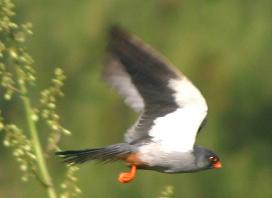ISLAND CONSERVATION-The falcon invasion |24 December 2007


The male bird is particularly striking being mainly dark sooty grey with white flashes under the wings and bright orangey-red bill and legs. The female is quite different and more streaked but with similar bright bill and legs. They hunt from perches, swooping to the ground to take large insects. In Seychelles they seem to be particularly fond of airstrips on small islands where the trees at the margins provide look-out sites and the open grassy ground provides the insect prey. However, they also occur on other islands (especially North Island it seems) where there is no airstrip.
Amur Falcons have a unique migration route over open ocean. They breed in extreme north-east Asia, migrating in late September south-westward to Assam. Then they cross the Indian Ocean to south-eastern Africa, where they start to arrive in November. So, perhaps it is not surprising that a few make it to Seychelles. Well, yes and no. Until 1995 no-one had ever reported one in Seychelles. The entire world population passed to the north of Seychelles, just cutting the north-west corner of the Indian Ocean around the Arabian Sea to shorten the trip to Africa a little.
Then in 1995 two were seen on Desroches. Then they started to appear on Bird, Cousine, Aride, Mahé, Praslin and throughout the Amirantes south to Alphonse but never (so far) Farquhar or the Aldabra group. They are now reported to Seychelles Bird Records Committee more often than any of the other 150 vagrant bird species recorded in Seychelles. Something has changed. A few records in one year might be explicable. In two consecutive years it might be a coincidence. But now we are seeing this year after year for more than a decade and it is fairly safe to say something has happened, but what?
Migratory birds are driven by an urge to move that is driven by something similar to an in-built computer programme. They pick up signals from the landscape, the stars and the earth’s magnetic field, process the information and then keep to remarkably fixed paths. All of these sources of information are relatively fixed although the weather can blow them off course now and then. This might explain irregular occurrences of some species in Seychelles but it would not explain a trend. Unless there has been a more long-term change in the weather patterns over the Indian Ocean.
Could the Amur Falcon be telling us something about climate change in the Indian Ocean? Is this why they are migrating further south over the ocean and taking in a Seychelles stop-over? It’s difficult to say but Seychelles is in a fantastic position to collect bird records like this and by looking at changes over time, seeing what we can learn.
The Island Conservation Society promotes the conservation and restoration of island ecosystems.




